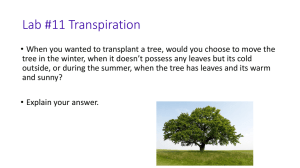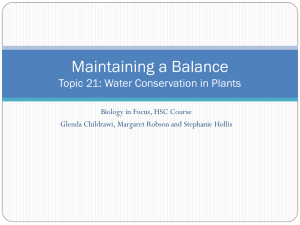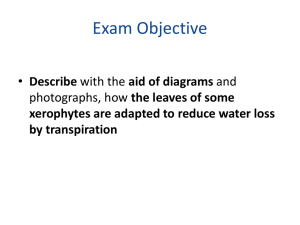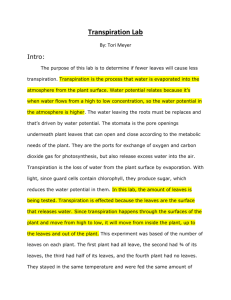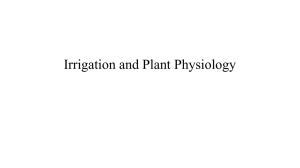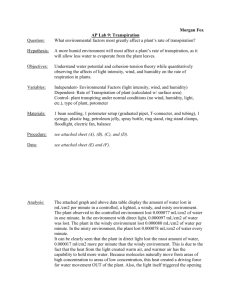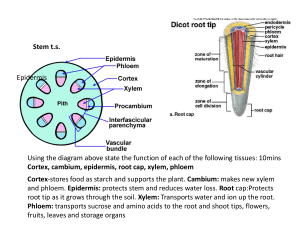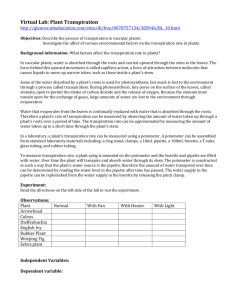Transpiration - The flow of water through a plant
advertisement
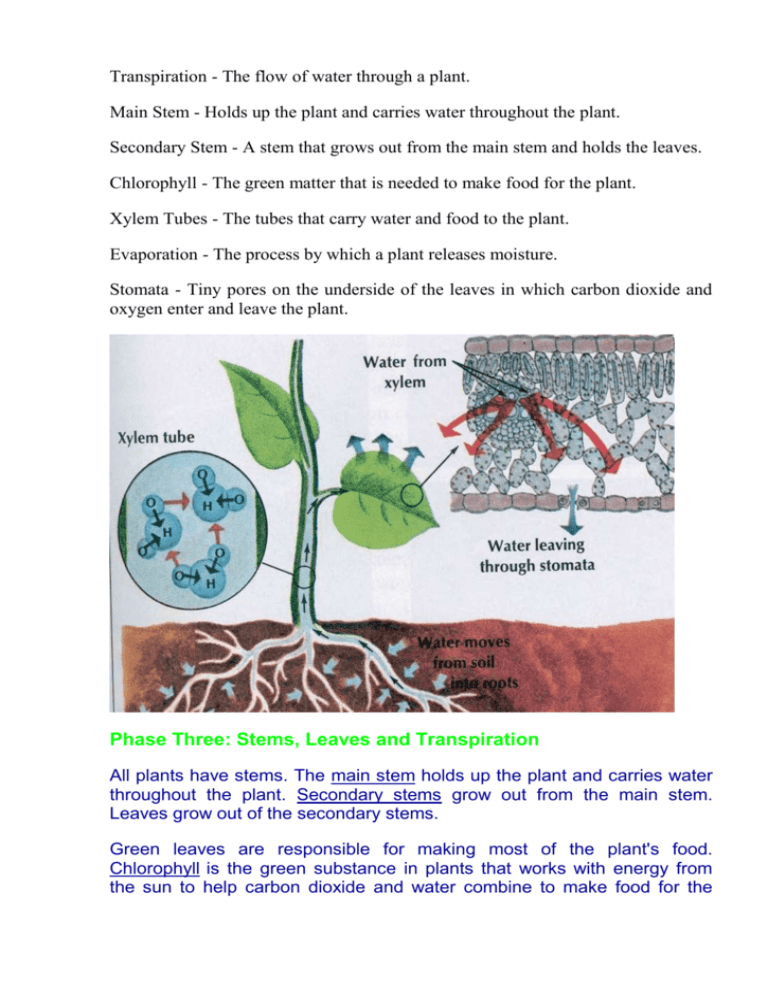
Transpiration - The flow of water through a plant. Main Stem - Holds up the plant and carries water throughout the plant. Secondary Stem - A stem that grows out from the main stem and holds the leaves. Chlorophyll - The green matter that is needed to make food for the plant. Xylem Tubes - The tubes that carry water and food to the plant. Evaporation - The process by which a plant releases moisture. Stomata - Tiny pores on the underside of the leaves in which carbon dioxide and oxygen enter and leave the plant. Phase Three: Stems, Leaves and Transpiration All plants have stems. The main stem holds up the plant and carries water throughout the plant. Secondary stems grow out from the main stem. Leaves grow out of the secondary stems. Green leaves are responsible for making most of the plant's food. Chlorophyll is the green substance in plants that works with energy from the sun to help carbon dioxide and water combine to make food for the plant. Plants pull water upward from the soil through xylem tubes in a process called transpiration. Transpiration is controlled by the moisture content of the air and soil. Only 1 percent of the transpired water is used in the growth process. Transpiration also transports food from the soil into the roots and carries it to the different cells of the plant. As the sun warms the water inside the plants leaves, transpiration occurs. This warming causes most of the water to turn into vapor and evaporate. The water vapor escapes into the air through the stomata. The water vapor absorbs heat as it escapes, which cools the inside of the leaves. The roots of the plant draw up more water to replace what was lost. The water travels up the stem and along the veins of the leaves through the xylem tubes. Transpiration is the evaporation of water from plants. It occurs chiefly at the leaves while their stomata are open for the passage of CO2 and O2 during photosynthesis. Plant adaptations Plants are also adapted to living in different conditions. Most of the plant adaptations help to control the amount of water lost by the plant due to transpiration. Plants living in dry or very cold conditions, such as where water is frozen, need to decrease the amount of water lost by transpiration. On the other hand, plants which live in very humid conditions need to increase the amount of transpiration. This can be achieved in a number of ways: The number of stomata Most of the water vapour is lost through the stomata. A smaller number of stomata implies that transpiration will be significantly reduced. This is the case for plants living in very dry or very cold conditions. Plants living in wet or very humid conditions tend to have many stomata so as to allow transpiration to take place. Leaf fall Certain trees with broad leaves can lose their leaves in winter. By doing this, this helps prevent excessive water loss, since no transpiration takes place. Such trees are called deciduous trees. Herbaceous plants (the grasses) hibernate in seed or bulb form, which are underground storage organs, which then grow again in spring. Leaf Shape Trees which are not deciduous have leaves with a small surface area which are kept all throughout. These are called evergreen trees. The Pine tree is one of these trees, having needle-like leaves which account for a lower rate of transpiration than broad leaves. Some trees having broad leaves can curl up so that the epidermis is enclosed, thus reducing the rate of transpiration. Waxy Cuticle A thicker waxy cuticle reduces transpiration. The thicker the cuticle, the less the water loss. Position of Stomata Some plants have their stomata sunken below the epidermis of the leaf. This implies that any water which evaporates is trapped in the small piths which enclose the stomata, thus reducing water loss. On the other hand, plants such as the Water Lily, which have ample supply of water have their stomata on the upper surface of the leaf epidermis. Sunken Stomata Ficus sp. Water-Lily stomata on upper epidermis

